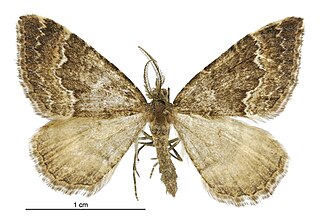
The bright-line brown-eye is a moth of the family Noctuidae. The species was first described by Carl Linnaeus in his 1758 10th edition of Systema Naturae. It is a common species throughout Europe, but is also found in North Africa, temperate North Asia and Central Asia, Asia Minor, Syria, and Turkestan, northern India, China, Korea and Japan.
Scodes is a genus of moth in the family Gelechiidae. It contains only one species, Scodes deflecta, which is found in the United States, where it has been recorded from Arizona.
Agonopterix cajonensis is a moth in the family Depressariidae. It was described by John Frederick Gates Clarke in 1941. It is found in North America, where it has been recorded from California.
Agonopterix costimacula is a moth in the family Depressariidae. It was described by John Frederick Gates Clarke in 1941. The Global Lepidoptera Names Index lists it as a synonym of Agonopterix nigrinotella. It is found in North America, where it has been recorded from Maryland, Michigan, Ohio and Ontario.
Agonopterix pteleae is a moth in the family Depressariidae. It was described by William Barnes and August Busck in 1920. It is found in North America, where it has been recorded from Illinois, Michigan and Ohio.
Hypatima corynetis is a species of moth in the family Gelechiidae. It was described by Edward Meyrick in 1913. It is found in Sri Lanka.
Chionodes lophosella is a moth in the family Gelechiidae. It is found in North America, where it has been recorded from Washington to California.
Palinorsa literatella is a moth in the family Depressariidae. It was described by August Busck in 1911. It is found in French Guiana.
Gonionota bourquini is a moth in the family Depressariidae. It was described by Clarke in 1964. It is found in Brazil and Argentina.
Gonionota contrasta is a moth in the family Depressariidae. It was described by Clarke in 1964. It is found in Peru.
Gonionota determinata is a moth in the family Depressariidae. It was described by Clarke in 1964. It is found in Guyana and Venezuela.
Gonionota dissita is a moth in the family Depressariidae. It was described by Clarke in 1964. It is found in Trinidad.
Gonionota excavata is a moth in the family Depressariidae. It was described by Clarke in 1964. It is found in Mexico.
Gonionota fimbriata is a moth in the family Depressariidae. It was described by Clarke in 1964. It is found in Panama.
Gonionota hyptiotes is a moth in the family Depressariidae. It was described by Clarke in 1964. It is found in Mexico.
Gonionota incontigua is a moth in the family Depressariidae. It was described by Clarke in 1964. It is found in Venezuela.
Stenoma rosa is a moth in the family Depressariidae. It was described by August Busck in 1911. It is found in Brazil and the Guianas.
Chlamydastis lactis is a moth in the family Depressariidae. It was described by August Busck in 1911. It is found in the Guianas and Brazil.

Austramathes purpurea is a species of moth in the family Noctuidae. It is endemic to New Zealand and can be found throughout the North and South Islands but has yet to be recorded at Stewart Island. It inhabits native forest. This species might possibly be confused with A. pessota, however this latter species does not have the purple hue to the forewings. The larvae of A. purpurea feed primarily on māhoe but have been recorded as feeding on, and have been reared on, narrow-leaved māhoe. The larvae pupate in a silken cocoon on moss covered ground. Adults can be found on the wing during the months of March to January but mainly occur during New Zealand's late autumn, winter, and spring. Light trapping may not be the most efficient technique for collecting this species.

Asaphodes ida is a species of moth in the family Geometridae. It is endemic to New Zealand. This moth can be found in upland or alpine habitat in Canterbury and Otago. Although not classified under the New Zealand Threat Classification system, this species is regarded as rare.


